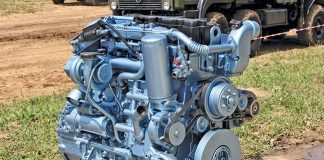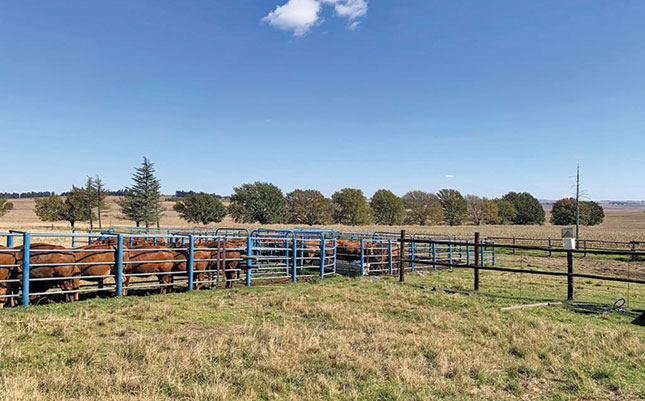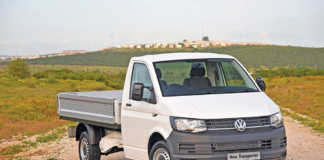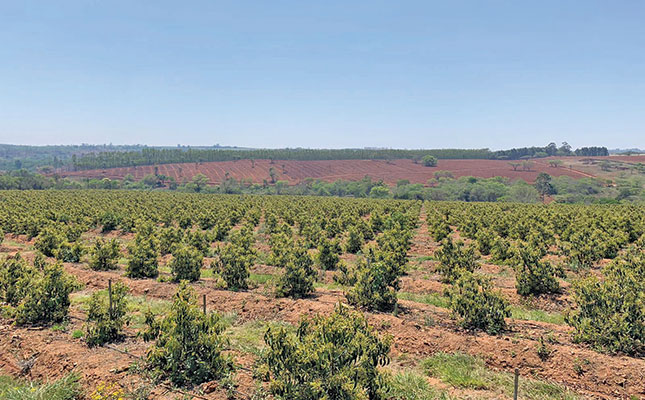
Photo: Lindi Botha
There can be few avocado producers who have been forced to re-establish their orchards on two separate occasions. Kosie Eloff and his son Manie in Limpopo are among them. But rather than merely repeating the exercise, they used it as an opportunity to introduce ridging in some of their orchards and compare the results with non-ridged orchards.
The story begins in 1976, when Kosie’s family were forced to sell part of their avocado farm, Welgevonden, near Morebeng (then Soekmekaar) to government, as it fell under a proposed homeland. In 1991, government gave the Eloffs the option of buying back the land.
Kosie jumped at the opportunity, but then faced the reality of having to re-establish his avocado orchards on this land. No cultivation had taken place in the meantime, and the orchards had become overgrown by black wattle and Lantana.
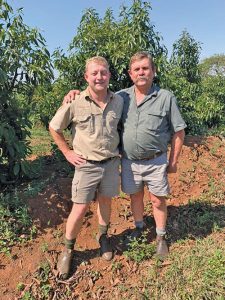
“It was a huge task, so I needed to borrow money, and I decided to go big. If I was going to go bankrupt, it might as well be for a large amount,” laughs Kosie.
The commercial banks, however, didn’t share his appetite for risk, and not one was willing to grant financing. Eventually, the Industrial Development Corporation (IDC) agreed to grant him a loan, which he used to establish 90ha of avocados within a year.
“By grace, I didn’t go bankrupt and could continue successfully with the avocados,” recalls Kosie. “But then, in 2009, the farm was hit by a hailstorm, and my son Manie and I were unable to harvest a single avocado from 20 000 of the worst-affected trees. Fortunately, the [IDC] was patient, and we managed to re-establish these orchards, too. Today, we have 300ha under avocado trees.”
Soil preparation
When avocados were re-established on the farm in 1991, a tractor and plough were used for soil preparation. Kosie admits that in hindsight, this was inadequate. “The soil needs to be properly ripped much deeper to loosen it up.”
Up to this point, all the avocado trees, which were of the Hass variety, were planted on level lands. When the Eloffs needed to replace the damaged orchards, they decided to try planting on ridges, which was the prevailing method at the time.
This gave them an ideal opportunity to compare production between trees planted on level land and those planted on ridges. In addition, some of the ridged trees were watered by micro-irrigation, and others by low-flow drip irrigation, which allowed another factor to be compared.
The Eloffs also broke with their practice of using only the Hass cultivar and introduced the Gem, planting them on ridges as well.
“We have particularly good soils and a ready supply of water, so our thinking had always been that we didn’t need to ridge. And the view of drip irrigation was that it didn’t have the ability to wet such a big surface area properly,” explains Manie.
“But both the ridges and low-flow drip irrigation seemed to be ‘in fashion’, so we thought we’d test them to see for ourselves whether they worked. The blocks where these methods were implemented did really well, so we decided to expand the principle on the farm.”
In addition, the Eloffs made the ridges as wide as possible, as this is the area where the roots grow and flourish, so the more room they have, the better. The inter-row spacing was made just wide enough for a tractor to pass through, since anything more would be a waste of space. A spacing of 8m x 4m was used in the Hass orchards, while 6m x 3m was used in the case of the Gem, as the latter are a dwarf variety.
The land was cross-ripped and markers were placed in the soil to indicate the position of the ridges and roads.
To make the ridges, the Eloffs had three options: a bulldozer, a grader and an excavator.
“We didn’t like the fact that the grader moves over the ripped soil several times while making the ridges,” says Manie. “This recompacts the soil that you’ve just spent time and money on loosening, so we excluded the grader option.
“At that stage, excavator technology was not as good as it is now; the implement took the soil at the bottom and threw it on top, and we didn’t want that. So we excluded the excavator, which left us with the bulldozer.
“We started off with Caterpillar D8 bulldozer, which ripped to an average depth of 700mm to 850mm. In later years, we changed to a D11 bulldozer, which rips to a minimum of 1m.”
Cost-efficiency
Manie laments that the cost of soil preparation is “frightening”. Nonetheless, through experimenting and careful calculation, they have managed to reduce it as far as possible.
When the last orchard was prepared in 2021, a D8 bulldozer cost R650/hour to rent, compared with the larger, more powerful D11, which cost R1 000/hour. Despite this difference, the Eloffs soon found that the overall cost was roughly the same, because the D11, being more powerful, was able to finish the job in a shorter time. They ended up using the D11 to make the ridges.
In this operation, the bulldozer pushes the soil onto a pile alongside the marker, first from the right side, then from the left, then from the right again.
“The downside of the bulldozer is that it produces a bit of an embankment in the middle of the ridge. If you use drip irrigation, you have to flatten this ridge top so that the water can pool at the roots and not just run off. To do this, we used a 6t excavator and flattened the top with the bucket,” explains Manie.
The cost of cross-ripping (including diesel) was around R15 000/ ha in 2021, depending on the soil. The cost of making and flattening the ridges came to R13 000/ha, but it would be R20 000/ha if an excavator were used for the entire process.
Manie notes that the drivers who perform the ridging have improved their skills over time, to the extent that very little intervention from the farmer is required.
Less water spent on irrigation
The availability of water is a limiting factor for any farmer planning orchard expansion. In the case of the Eloffs, they optimised their irrigation systems.
Welgevonden has water rights to 6 000m³/ year. By employing micro-irrigation, they use 3 000m³/ year for their 300ha of avocados, while low-flow drip irrigation requires only 1 500m³/year. This means that they can quadruple the hectares under production, which is why they are gradually switching over to low-flow drip irrigation. This system provides an astonishing flow of water that wets the entire ridge, says Manie.
“We haven’t seen the same kind of moisture levels in the non-ridged orchards. The roots are far better fed with low-flow drip irrigation, in combination with the ridges. The ridges are 500mm high and you’d think the roots would stay in that zone, but we’ve seen them grow 1m down.”
The system uses two dripper lines that run alongside the trees, 1m apart. One dripper is placed close to the trunk and the other an equal distance between two trees in the row.
The area receives average annual rainfall of 970mm. It is crucial to manage water flow to ensure that the trees get enough water, but without succumbing to root rot. The Eloffs therefore only irrigate the orchards from April to October. During summer, the trees rely on rainfall only.
In winter, Manie mimics rainfall by using low-flow drip irrigation, as this method wets the surface to the same extent that rain does. Moreover, it requires far less water than micro-irrigation to fully wet the surface.
Fertilisation, too, is governed by the season. In winter, irrigation is applied, and fertigation is therefore used. In summer, with no irrigation being used, fertiliser (in granular form) is applied by hand. Fertiliser is applied four times a year.
The proof is in the harvest
With the various cultivation and irrigation methods used on the farm, the Eloffs were able to make direct comparisons and see which worked best for them. Hass trees planted on a level surface that received micro-irrigation, for example, did not produce a harvest in years one or two.
Year three produced a harvest of 2t/ha, year four 5t/ ha, year five 10t/ha, and year six 15t/ha. From this point, the trees were in full production and followed the normal alternate-bearing cycle.
Hass trees planted on ridges that received micro-irrigation produced their first harvest (about 0,5t/ ha) in year two. Year three produced 5t/ha, year four 15t/ ha, year five 12t/ha, and thereafter 15t/ ha. Manie notes that the dip in year five appeared to be the result of the tree producing too much, too soon in year four, and then taking a year to build up reserves.
Despite the dip, the comparison showed that ridges provide a major advantage, with the trees coming into production far sooner and the yields being considerably larger.
“In year three alone, we got an extra 3t/ ha by planting on ridges. At R15/kg, this equates to R45 000. This means the added cost to ridge is already paid back with the harvest in year three.
“It really doesn’t make sense not to ridge. We have good soils and sufficient water, but ridged orchards still perform far better than those on level surfaces,” says Manie.
Email Manie Eloff at [email protected].









